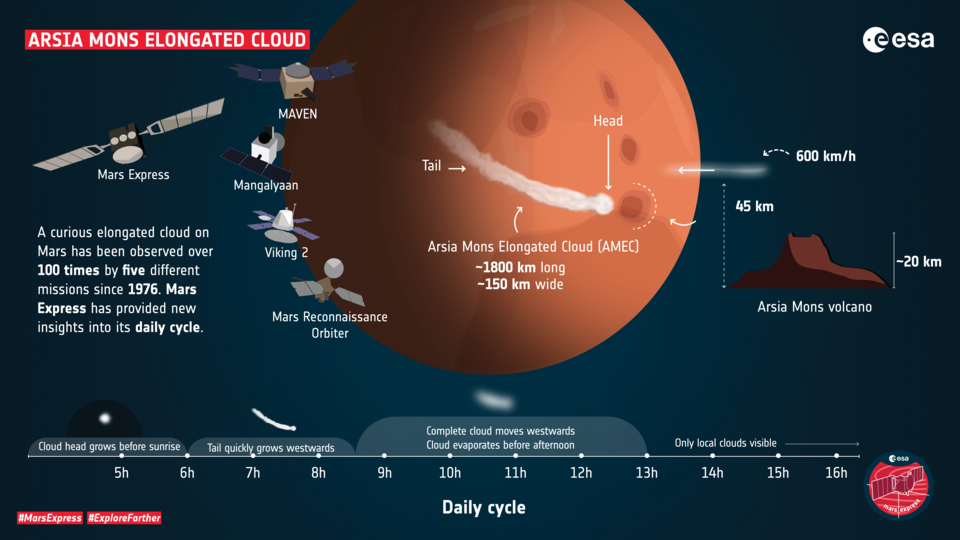
In 2018, a camera onboard the Mars Express mission caught sight of an oddly long and wispy cloud, billowing across the surface of the Red Planet.
From a distance, the 1,500-kilometer (930-mile) trail of fog almost resembled a plume of smoke, and it gave the impression to be emerging from the highest of a long-dead volcano.
Looking back at archived images, researchers soon realized this had been happening for ages. Every few years in spring or summer, this curious cloud would return, before disappearing yet again. The fleeting plume was caught on camera in 2009, 2012, 2015, 2018, and again in 2020.
A newly published study has now detailed the explanations behind why this unfathomably long cloud keeps coming and occurring on Mars. To do this, researchers compared high-resolution observations of the 2018 plume to other archived observations, a number of which stretch back all the thanks to the 1970s.
Here's the cloud's story. Each year, around the start of spring or summer within the southern Martian hemisphere, the Arsia Mons Elongated Cloud begins to require shape.
At dawn, dense air from the bottom of the Arsia Mons volcano begins to climb up the western slope. As temperatures drop, this wind expands, and also the moisture within it condenses around particles of dust, creating what here on Earth we call an orographic cloud.
Each morning, over the course of several months of observations, researchers watched this process repeat itself. At about 45 kilometers altitude, the air begins to expand, and for the subsequent 2.5 hours around, the cloud is pulled westward on the wind, as fast as 600 kilometers per hour (380 mph), before finally detaching from the volcano.
At its largest, the plume can reach 1,800 kilometers long (more than 1,100 miles) and 150 kilometers broad (nearly 100 miles). By noon, when the Sun is at its apex, the cloud will have completely evaporated.
Ice clouds aren't exactly unusual on Mars, but the clouds above Arsia Mons still form in summer when most others disappear. In fact, much of the time, this specific volcano encompasses a cloud sitting on top of it when others around it don't – but only under some conditions does it unfolded in a very long streak. (Each year, at the beginning of winter, this cloud may also form a spiral.)
 Profile of the Arsia Mons Elongated Cloud. (ESA)
Profile of the Arsia Mons Elongated Cloud. (ESA)
So if this long plume is going on daily for a stretch of your time every year, why can we only have sporadic observations of it?
Researchers say it's because many of the cameras orbiting Mars are only occasionally flying over this region within the morning, and observations are usually planned, which implies we are often taking shots of this cloud just by chance.
Luckily, an old camera still onboard the Mars Express mission – the Visual Monitoring Camera (VMC) which has the facility of a 2003 webcam – has one perk newer technology doesn't.
"Although [the camera] features a low spatial resolution, it's a good field of view – essential to determine the large picture at different local times of day – and is wonderful for tracking a feature's evolution over both a protracted period of your time and in small time step," explains astronomer Jorge Hernández Bernal from the University of the Basque Country in Bilbao, Spain.
"As a result, we could study the full cloud across numerous life cycles."
The study represents the primary detailed exploration of the Arsia Mons cloud, and while scientists say it holds similar properties to orographic clouds on Earth, its size is gigantic and its dynamics quite vivid as compared to what we see on our own planet.
"Understanding this cloud gives us the exciting opportunity to undertake to copy the cloud's formation with models – models that may improve our knowledge of climatic systems on both Mars and Earth," says astronomer Agustin Sánchez-Lavega, also from the University of the Basque Country.
Now that we all know when the cloud occurs, it also allows us to direct other, stronger cameras in orbit to the correct place at the correct time, providing us with a more in-depth glimpse. it should not be too long until the subsequent pics.
The study was published within the Journal of Geophysical Research.
 Reviewed by Admin
on
March 15, 2021
Rating:
Reviewed by Admin
on
March 15, 2021
Rating:



No comments: